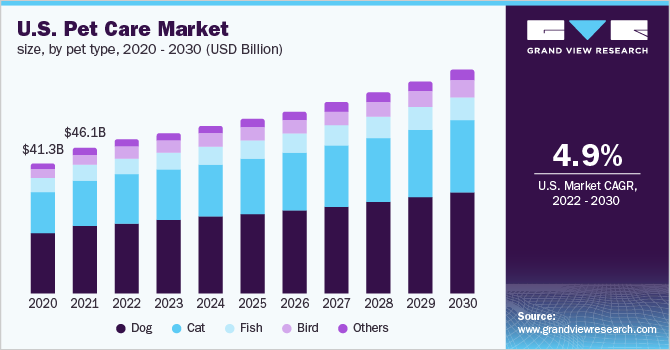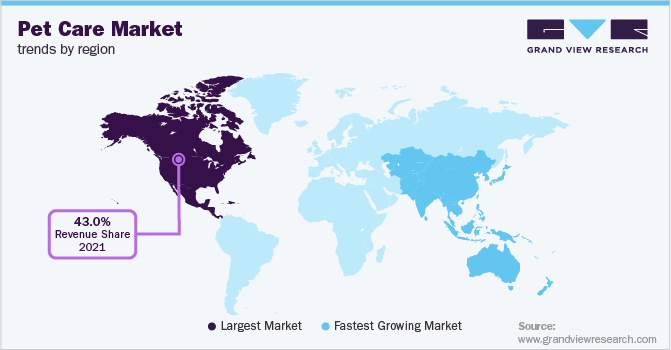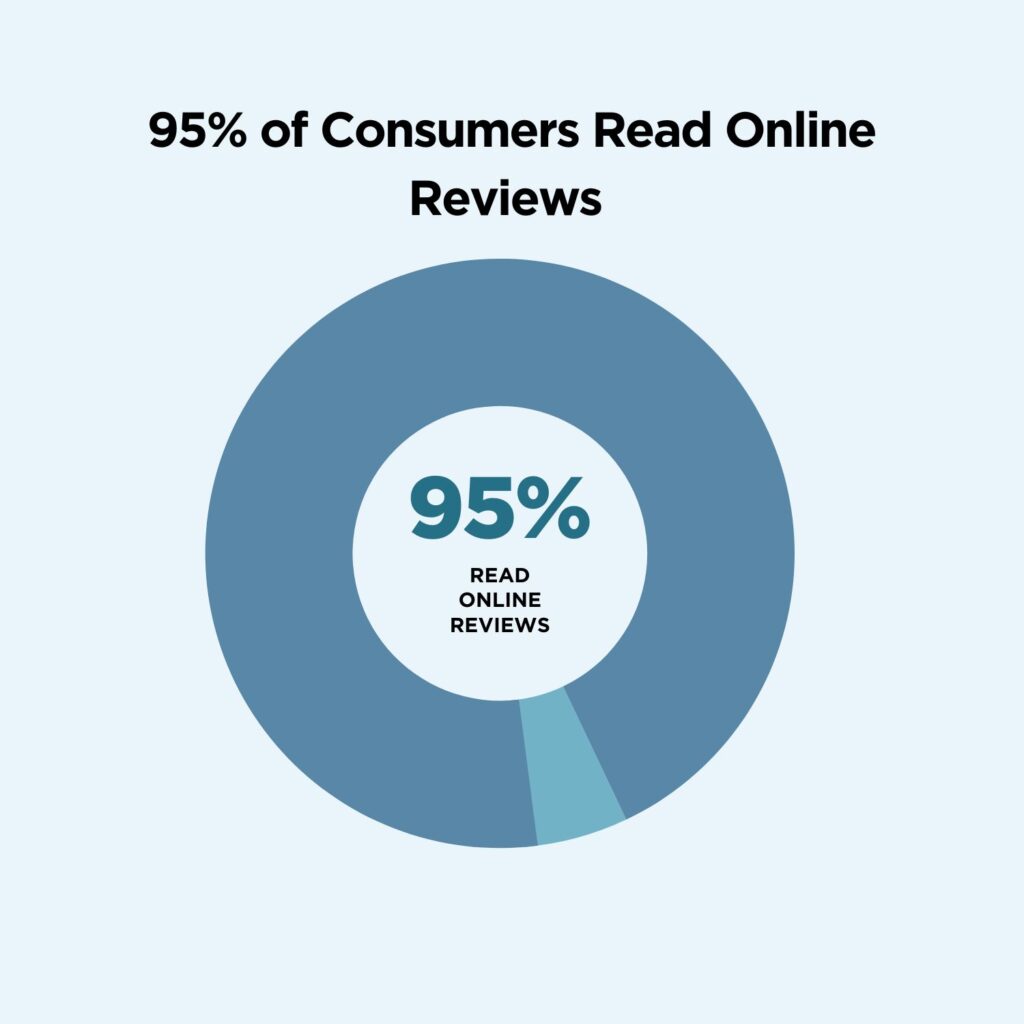The pet industry continues to experience impressive growth, with expenditures topping over $100 billion in 2020 in the United States alone. As more households welcome furry friends, demand rises for pet products and services.

Launching a pet business allows you to cater to devoted pet owners who are always seeking to enrich their pets’ lives. Seventy percent of US households now include at least one pet, illustrating the vast customer base to target.
This guide will walk you through how to open pet store-style businesses. Topics include sourcing pet supplies, market research for a thorough business plan, competitive analysis, forming an LLC as a pet store owner, obtaining pet shop business insurance, and more.
1. Conduct Pet Market Research
Market research is integral to local pet store owners. It offers insight into important details about the pet supply store business market, such as service trends and information on your target market. There are two types of market research, primary research you compile yourself and secondary research compiled by somebody else.

Some details you’ll learn through pet supply shop market research include:
- The market is divided store-style between supplies and services like cat or dog food, pet treats, toys, and beds along with veterinary care, grooming, and boarding.
- As millennials delay marriage and kids, pets become “starter children” benefiting from significant spending.
- Pet humanization drives innovation like high-end food, advanced healthcare, tech-enabled products, insurance, and even pet-friendly accommodations.
- Venturing into the crowded pet space requires identifying an underserved niche.
- Go hyper-specialized with a DTC e-commerce, brand, pet tech invention, pet bakery, training classes, walking services, photography, clothing, or other novel concepts.
- As consumers increasingly humanize pets, demand rises for premium services like doggy daycares, tech-enabled pet trackers, telehealth, in-home sitting, and humanization-focused products.
- The veterinary industry sees steady, 5-6% year-over-year growth, lifted by pet insurance reimbursement expanding treatment options.
- Veterinary consolidators roll up independent clinics into corporate networks year-over-year while tech-forward telehealth offerings emerge.
- Both trends provide M&A or partnership opportunities for innovation-focused newcomers.
- Independent pet retailers similarly benefit from leveraging e-commerce and niche offerings to triumph over Amazon and big box competition.
Humanization, experiences, healthcare, tech-enabled offerings, and pet aging/wellness needs all represent prime openings. Capitalize on America’s pet-obsessed consumer culture and unlock this $100 billion market’s immense potential.
2. Analyze the Competition
For brick-and-mortar competitors, track down local pet stores, groomers, boarding facilities, veterinarians, and related operators. Visit their establishments, and e-commerce nor scrutinize service offerings and prices. Evaluate the customer experience, are staffers knowledgeable?

Some ways to get to know other business owners in the pet store industry include:
- Identify potential gaps like specific products not carried locally.
- Benchmark local competitor digital presences using SEMrush to analyze website traffic, search visibility, and social media engagement.
- Paths to differentiation emerge from qualitative insights during in-person visits combined with an awareness of digital traction.
- For e-commerce and digital pet startups, benchmark competitors beyond geography.
- Evaluate product selection, branding, pricing, reviews, and site experience.
- Sign up for email lists to analyze customer communication styles.
- Follow social channels to assess engagement levels and content types.
- Use Alexa to track competitor website traffic stats over time.
- Install Google Analytics on your site to ultimately monitor market share gains achieved by luring visitors away from established players.
By immersing in the first-hand customer experience of local brick-and-mortar pet businesses while leveraging data to deeply understand digital operator traction, founders lay the foundation for a competitively differentiated new entrant.
3. Costs to Start a Pet Business
Launching a pet business necessitates thorough financial planning and cost analysis to set the venture up for sustainability. Based on decades of small business consultancy, pet startups require the following estimated expenses:
Startup Costs
- Registration/licensing fees: $50-$500+ depending on business structure
- Commercial lease deposit: Typically 1-3 months rent; $5,000+
- Initial inventory purchase: $2,000-$20,000+ depending on products (food, treats, accessories, toys, etc.)
- Store build-out/renovations: $5,000-$30,000+
- Equipment like registers & shelving: $2,000-$10,000
- Business insurance: $500-$5,000/year
- Professional services (legal, branding): $500-$5,000
- Initial marketing assets and campaigns: $500-$5,000
Total Startup: $15,000-$100,000
Ongoing Monthly Costs
- Rent: $2,000
- Inventory replenishment: Industry dependent
- Payroll including own salary: Employee dependent
- Software subscriptions: $100
- Utilities: Industry/space dependent
- Advertising: $250
- Credit card processing fees: 1-5% of revenue
- Pet insurance premiums: $30 per pet
Ongoing Costs
- Insurance premium: Industry rate
- License renewal: $100
- Professional development/continuing education credits: $500
- Marketing campaigns: $500-$5000
- Accounting services: $1200
Manage cash flow diligently, as unforeseen pet emergencies or seasonal revenue dips can readily torpedo still-establishing businesses. Seek professional advice to craft financial plans factoring in diversified income streams via product sales, services, pet hotels, and other offerings to mitigate risk.
4. Form a Legal Business Entity
When establishing a pet business, carefully weigh entity structuring to optimize for liability protection, taxation, and long-term goals. As an attorney specializing in small business formations for over 20 years, I recommend pet startups organized as LLCs.
Sole Proprietorship
Sole proprietorships offer the easiest setup with no formal registration requirements beyond requisite licenses. The owner assumes unlimited financial and legal responsibility, risking personal assets like houses if sued. While expedient initially, consider evolving beyond sole proprietorship to responsibly scale a pet venture.
Partnership
Partnerships allow the sharing of profit, loss, and liability with a co-owner per contractual agreements. However, all partners remain jointly responsible for debts and legal actions. This structure works best for small, highly aligned partners like husband-wife pet retail shops.
Limited Liability Company (LLC)
Conversely, LLCs limit owner liability to invested assets while shielding personal assets. LLCs require more paperwork and registration fees but enable easier financial and managerial restructuring over time. This facilitates adding employees or partners down the road. An LLC also represents a tax-advantaged structure suited to pet businesses targeting profitability.
Corporation
Larger corporations allow raising VC funding by selling shares but require extensive tracking of ownership stakes. Significant legal paperwork burdens make this entity a poor fit for early-stage pet ventures. Form a simpler LLC now to smooth future expansion rather than prematurely incorporating.
5. Register Your Business For Taxes
Launching a pet business obligates owners to obtain critical registrations for federal and state tax compliance. An EIN, or Employer Identification Number, establishes a unique entity identifier with the IRS fundamental for LLCs and corporations.
As counsel for over 15,000 small business formations, I urge pet startups to apply for an EIN even if not hiring employees. This ID number enables opening business bank accounts, applying for licenses/permits, and filing tax returns for your pet LLC or corporation.
The streamlined modern process facilitates online EIN registration on IRS.gov. You must first determine your business structure – sole proprietor, partnership, LLC, or corporation. Next provide basic information like name, address, and owners’ SSNs. The IRS instantly issues your EIN.
Remember to also contact your Secretary of State to formally register your pet business while establishing state sales tax collection protocols. States levy additional nominal registration fees. However, properly structuring your entity legally separates your company from personal liability risks.
6. Setup Your Accounting
After forming thousands of pet startups, meticulous financial tracking emerges as a prerequisite for success. Adhere to legal and tax compliance while leveraging automation to efficiently manage finances. Here’s how:
Accounting Software
Institute accounting software like QuickBooks immediately to categorize and reconcile every transaction while integrating with bank/credit card accounts. This captures income and expenses in real time across all cash flow avenues. Dedicate QuickBooks user permissions to appropriate staffers only so records remain immutable.
Open a Business Bank Account
Designate a separate business bank account exclusively for pet shop deposits, payments, and withdrawals. Never commingle with personal finances. Cleary delineating business vs personal money streamlines accounting supports bank loan applications, and saves headaches come tax season.
Apply for a Business Credit Card
Apply for a dedicated business credit card enabling transparent tracking/budgeting of all pet shop expenditures. Business cards weigh company income, not personal credit scores when determining limits. Provide your EIN and share financial documentation like QuickBooks records during applications.
7. Obtain Licenses and Permits
When founding pet businesses, securing requisite licenses and permits averts disruptive legal quagmires down the road. Find federal license information through the U.S. Small Business Administration. The SBA also offers a local search tool for state and city requirements.
Pet retail sellers must obtain a state business license to operate within associated districts. These grant baseline permissions to conduct commercial transactions as an LLC or corporation. County/municipality jurisdictions also issue their localized versions – look for specific requirements with your Secretary of State.
Selling pet food products obligates securing FDA registration. This oversight ensures proper branding, nutritional standards, production protocols, and ingredient safety. Separate approvals apply for importing exotic pet nourishments. Consider any specialized dietary offerings early to allow licensing lead time.
For pet healthcare services like veterinary clinics or grooming salons, obtain a DEA registration authorizing administering or supplying controlled medications. Individual staffers also need associated licenses to prescribe, dispense, or handle these drugs.
Brick-and-mortar pet facilities with public access should verify ADA compliance regarding accessibility accommodations from parking to interior navigation. Document diligent efforts to support disabled individuals.
finally, consult local zoning codes and homeowner associations before establishing home-based or residential pet businesses. Selling pets from one’s home risks substantial fines absent proper permissions.
8. Get Business Insurance
My 30 years steering small business formations instilled an unequivocal maxim – secure business insurance immediately. Failing to safeguard your nascent pet venture via policies tailored to industry-specific risks courts disaster. Consider three scenarios demonstrating how uninsured pet businesses readily collapse:
An unattended candle ignites an inferno within your doggy daycare, ravaging the facility and lacking fire insurance, rebuilding costs force permanent closure. Renter’s or home insurance excludes commercial activities – no coverage.
A pet grooming customer sues after alleging employee negligence injured their dog. Six-figure legal fees drain cash reserves fast without liability insurance. Personal assets are now jeopardized.
A vehicle accident by your pet-sitting staff member injures pedestrians. Victims rightfully demand compensation given incapacitating injuries. With no auto or commercial liability coverage, expectations for business longevity dim.
The prospect of folded companies and financial ruin spurs properly insuring pet ventures before opening doors. But the process need not intimidate.
Craft detailed summaries of all business activities across inventory, staff, facilities, and vehicles. Estimate yearly gross revenues. Gather any regulatory licenses.
Receive quotes from multiple commercial insurance brokers on tailored policies shielding your specific operations. Weigh offerings based on premiums, deductibles, exclusions, and extent of protection across property damage, lawsuits, and accidents.
9. Create an Office Space
Securing office space fuels productivity for pet businesses by providing an official hub for conducting sales, marketing, and operations. Consider four real estate options based on the startup stage and budget:
Home Office
Working from one’s residence offers convenience and autonomy during the launch phases. Dedicate an unused bedroom as a home office for handling administrative tasks like QuickBooks, web development, and appointment scheduling. Beware of permitting restrictions if seeing clients at home. Expect costs of $100+ monthly for upgraded internet/phone plans to support a commercial venture.
Coworking Office
As the business matures, joining a shared coworking community like WeWork allows for leveraging amenities-rich space and networking with other entrepreneurs. Hotdesk open work areas to limit expenses to ~$300 monthly. Private offices cost $500+ but convey professionalism when meeting pet owners.
Retail Office
Pet retail models benefit from storefront visibility granted by commercial space leasing. Expect a large upfront security deposit plus ongoing rent of $3,000 monthly in most markets for 1,500 sq ft shop floors. However prime positioning could attract walk-in neighborhood traffic. Consider boutique pet malls offering smaller embedded store real estate.
Commercial Office
For larger pet ventures like veterinary clinics and full-service facilities, invest in dedicated commercial buildings. Expect $4/sq ft monthly rents in suburban regions for spaces spanning 5,000 sq ft. These convey the room for kennels, exam rooms, play areas, and storage that community pets deserve.
10. Source Your Equipment
Launching pet businesses obligates securing specialized equipment aligned with your particular niche. When sourcing requisite materials, consider four acquisition avenues balancing affordability and functionality.
Buy New
Retail websites like Chewy or PetCo offer one-stop shops for pet merchandise spanning food, toys, beds, and grooming tools. For medical equipment, browse MWI Veterinary Supply’s extensive catalog of diagnostic technology, kennels, and surgical implements. Buying new guarantees the latest products in optimal condition.
Buy Used
Inspect Craigslist and Facebook Marketplace for discounted secondhand equipment in usable shape. For example, established groomers often sell clippers, bathing stations, and kennels when upgrading tools. Expect 50-75% savings from retail. Request item demonstrations and inspect closely before purchasing.
Rent
Some specialty products like dog treadmills for temporary rehabilitation lend themselves to shorter-term rentals. Rent It Today offers flexible leasing periods for niche pet supplies. Make sure any electronics function properly throughout the rental. Clean kennels thoroughly upon return.
Lease
Veterinary practices involving diagnostic imaging technology costing $100,000 suit longer-term leases preserving capital. Contracts spanning several years allow spreading payments over time rather than huge upfront investments. Marlin Finance specializes in funding veterinary equipment leases.
11. Establish Your Brand Assets
Distinct branding sets thriving pet businesses apart by forging emotional connections with patrons. Define your essence through considered messaging, visuals, and experiences.
Getting a Business Phone Number
Calls represent sales opportunities. Acquire a professional number instead of relying solely on personal cell phones. Services like RingCentral provide toll-free and local numbers with custom greetings, voicemail, and call routing to any device.
Creating a Logo and Brand Assets
Commission a designer on Fiverr or use a DIY service like Looka to craft a timeless logo encapsulating your pet business vision. Scalable vector files allow flexible reuse on business cards, websites, and signage. Develop complementary brand colors, fonts, and graphic treatments to employ widely.
Creating Business Cards and Signage
Once the logo is finalized, order durable cards from Vistaprint for distribution at veterinary offices, dog parks, and community events. Prepare variations for each staffer listing individual phone/email contacts. Business cards answer pet parents’ poignant question – “Where can I learn more or reach out?” For physical facilities, install external signage viewable from the curb.
Purchasing a Domain Name
Secure a catchy, short .com domain encompassing your brand name via Namecheap for under $20. This real estate enables launching a customer-facing website while claiming your brand across social media. Brainstorm versatile names not already registered.
Building a Website
Construct a modern website through novice-friendly builders like Wix for displaying services, booking appointments, or e-commerce. For larger budgets, hire web developers to code custom designs at expected project costs ranging from $3,000 to $35,000. Well-designed websites establish credibility and facilitate reaching wider audiences.
12. Join Associations and Groups
Expanding professional networks fuels pet business success by tapping insider knowledge. Connect locally and virtually to learn best practices.
Local Associations
In-person trade groups like the American Pet Products Association and breed-specific circles offer camaraderie through regular meetings and events. Attend to gain mentorship, showcase products, learn regulations, and more. Expect nominal annual membership fees.
Local Meetups
Beyond formal associations, use Meetup.com to find casual pet meetups building the local community. Use meetups to convene canine fans for playdates, training workshops, and rescue outreach. Such groups unlock marketing opportunities and word-of-mouth referrals.
Facebook Groups
Navigate Facebook groups like Pet Business Professionals to pose questions in niche forums spanning thousands nationwide. United States online pet store also offers a 4.6K member sounding board to veteran shop owners.
13. How to Market a Pet Business
Marketing represents the lifeline between pet businesses and the beloved animals they serve. Strategic outreach to local networks and digital channels will organically expand your venture’s reach if approached thoughtfully.

Personal Networking
Recognize existing friends and family as inaugural brand ambassadors. Offer exclusive pre-launch deals to engender goodwill. Request reviews on Google and social media from satisfied early customers. Nothing catalyzes credibility more than cheerful community members sharing first-hand praise.
Digital Marketing Ideas
- Launch Google and Facebook ads geo-targeting nearby pet owners
- Post Instagram Reels showcasing pets enjoying your products
- Claim Google Business Profile and encourage customer reviews
- Launch a TikTok channel with cute or helpful pet content
- Guest blog for regional pet sites driving links and awareness
- Host free webinars on relevant pet care topics
Traditional Marketing Ideas
- Distribute engraved pet tags and flyers at veterinary offices
- Sponsor local dog walking groups and rescue events
- Negotiate an underwriting trade: free services in exchange for radio mentions
- Rent prominent billboard space along highly trafficked corridors
While digital channels grant efficient targeting and measurement, local pet lovers remain small businesses’ strongest supporters. Foster community through on-the-ground presence while leveraging select social media and PPC ads to sustain awareness.
14. Focus on the Customer
Pet businesses thrive through forging genuine emotional connections with customers – the animal lovers devoted to their pets’ happiness. Stellar customer service facilitates those relationships, earning trust and referrals. Some ways to better focus on customers as a successful pet store include:
- Consider a shopper seeking a special dietary kibble for their aging dog with pancreatitis issues.
- Take time to compassionately discuss their pet’s needs and restrictions.
- Guide them towards gentle digestion blends that best ease digestive woes.
- Offer free taste tests allowing their pup to demo potential new foods.
- Check-in afterward to monitor ongoing appetite and comfort.
- Such attentive care conveys that your business prioritizes beloved pets’ well-being rather than quick sales.
- Three new neighborhood regulars soon visit on a personal recommendation.
- Another example involves a client whose feline companion requires medication only available via veterinary dispensation.
- Offer to interface directly with the vet to arrange prompt prescription transfers so the anxious cat parent leaves assured that lifesaving medication continues uninterrupted.
When pet businesses value compassionate customer care as much as commerce, positive word-of-mouth spreads. New patrons arrive seeking your expertise and dedication in caring for their pets after hearing first-hand accounts.
